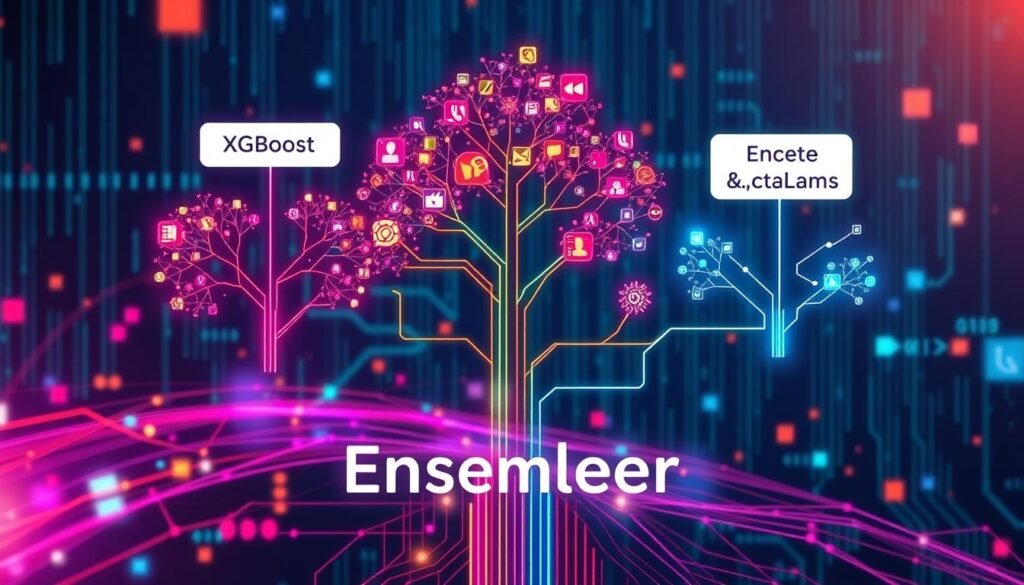GBMs Algorithm are key in predictive modeling. They are used in many areas like finance, healthcare, and e-commerce. These tools help data scientists turn data into useful insights.
Three GBM algorithms, CatBoost, XGBoost, and LightGBM, are getting a lot of attention. Each has its own strengths. This comparison aims to help you choose the best one for your needs.
Key Takeaways
- CatBoost, XGBoost, and LightGBM are top contenders in GBMs algorithm efficiency and effectiveness.
- Each algorithm possesses unique features tailored for handling categorical data, tree structures, and optimization strategies.
- Through techniques like ordered boosting and symmetric trees, CatBoost enhances prediction speed and combats overfitting.
- XGBoost excels in scalability and speed through parallel processing and built-in regularization, L1 and L2.
- With strategies such as GOSS and EFB, LightGBM offers faster computation suitable for large datasets.
- The choice among these algorithms requires thoughtful consideration of data characteristics, computational resources, and the nature of the task at hand.
An Introduction to GBMs Algorithm

Understanding Gradient Boosting in Machine Learning
Gradient Boosting is a powerful and widely-used machine learning technique known for building strong predictive models. At its core, it leverages ensemble learning—combining multiple weak learners, typically decision trees, to form a robust overall model. What sets Gradient Boosting apart is its use of the gradient descent algorithm to minimize errors in a step-by-step manner, improving accuracy with each iteration.
How Gradient Boosting Works
Gradient Boosting builds models sequentially, where each new model is trained to correct the errors made by the previous one. This process involves optimizing a loss function (such as log-loss for classification or mean squared error for regression) by calculating gradients and using them to guide improvements in subsequent trees.
It’s applicable to both classification and regression tasks, making it versatile across different domains and data types. The method adapts to continuous and categorical variables, commonly implemented through tools like the GradientBoostingClassifier and GradientBoostingRegressor.
Why Gradient Boosting Is Special
Boosting Weak Learners: It turns weak models (like shallow trees) into strong predictors by correcting past mistakes.
Gradient Descent Optimization: It uses gradients to reduce error in a structured, measurable way.
Customizable Loss Functions: Enables flexibility to apply in varied problem spaces.
Real-World Applications
Gradient Boosting is especially effective in complex domains like:
Financial forecasting
Healthcare diagnostics
Marketing and sales predictions
Fraud detection
Its high accuracy and ability to handle messy, real-world data make it a top choice in competitive machine learning environments.
Preventing Overfitting
Despite its strength, Gradient Boosting can overfit, especially with noisy data or an excessive number of trees. To address this, practitioners use:
Tree constraints (e.g., max depth, min samples per leaf)
Regularization (L1/L2 penalties)
Stochastic Gradient Boosting, which introduces randomness by training each tree on a random subset of data (subsampling), reducing variance and improving generalization.
Best Practices
To get the most out of Gradient Boosting:
Tune hyperparameters carefully (learning rate, number of estimators, tree depth, etc.)
Use cross-validation to evaluate model performance reliably
Apply early stopping to halt training once performance stops improving on validation data
Understanding Ensemble Learning: The Backbone of GBM
Ensemble learning is key in machine learning. It uses different models to improve accuracy and strength. This is great for solving complex problems.
The Concept of Ensemble Methods
Ensemble learning combines many algorithms to make better models. It uses the best parts of each model to overcome weaknesses. Together, these models are stronger than any one alone.
Exploring Bagging, Boosting, and Stacking
Bagging, boosting, and stacking are main techniques in ensemble learning. Bagging trains models on different data parts to reduce variance. Boosting adjusts the model based on previous results to lower errors.
Stacking uses predictions from different models to improve performance. It combines the strengths of various algorithms.
The Evolution of Boosting: From Theory to Practice
Boosting has grown from simple ideas to powerful tools. It started with AdaBoost, which learns from mistakes. Now, we have LightGBM, known for its efficiency in big data.
Learn more about LightGBM and its advanced techniques in this detailed exploration.
Ensemble learning uses many models together, like gradient boosting machines. Each model has its own way to improve predictions. These techniques solve real data problems.
The journey from a single model to a team is key. It makes prediction models smarter and more reliable. Ensemble methods help in business and medicine, uncovering deep insights.

GBMs Algorithm and Their Place in Predictive Modeling
GBMs Algorithm are key in predictive modeling. They are often chosen by data scientists for their efficiency and robustness. GBMs are great at handling different types of data, making them versatile in supervised learning.
Defining GBMs and Their Application
GBMs Algorithm are used in many supervised learning areas. They use weak learners to improve predictions step by step. This process aims to reduce errors, thanks to a loss function.
In programming tools like GBM Python or GBM R, GBMs have adjustable settings. These settings help fine-tune the model for specific training data.
Regressor and Classifier: Diverse Uses of GBMs Algorithm
GBMs Algorithm can be both regressors and classifiers. They adjust their decision trees to improve predictions. This makes them useful for many tasks.
In regression, GBMs Algorithm aim to predict continuous values. For classification, they sort data into categories. This is vital for many industries.
| Feature | Importance in Titanic GBM Model |
|---|---|
| Cabin | High |
| Sex | High |
GBMs Algorithm are great at handling different outputs. They use early stopping to avoid overfitting. This helps them perform well in various supervised learning tasks for classification and regression.
The Unique Mechanisms of CatBoost
CatBoost stands out in the world of GBMs Algorithm. It’s known for its special way of dealing with categorical features and boosting model accuracy. Yandex created CatBoost, making it a top choice in the machine learning algorithm field.
Symmetric Trees and Their Efficiency
CatBoost uses symmetric trees as its base. These trees are balanced, which helps the model run faster and avoid overfitting. The symmetry makes the algorithm more reliable and efficient.
Ranked Boosting Techniques in CatBoost
CatBoost’s ranked boosting techniques are a big plus. It outperforms XGBoost and LightGBM in some cases. CatBoost’s methods, like YetiRank and PairLogit, are great for ranking problems. This makes its predictions more accurate.
Native Support for Various Feature Types
CatBoost can handle different types of features easily. It works well with numbers, categories, and text without extra steps. Its approach to feature engineering is innovative, making it better at handling categorical features.
Here’s how CatBoost compares to other gradient boosting machines in feature processing:
| Feature Type | CatBoost | XGBoost | LightGBM |
|---|---|---|---|
| Categorical | In-built support with sophisticated encoding | No in-built method, requires manual preprocessing | Converts to numeric, might lose information |
| Numerical | Direct integration with minimal preprocessing | Needs preprocessing for optimal performance | Efficient handling but sensitive to scale |
| Text | Native support simplifies usage | Requires conversion to numeric | Not directly supported, needs feature engineering |
CatBoost is highly valued for its work with categorical features and easy feature engineering. Its ability to handle different data types makes it a powerful tool for complex tasks.
What Is XGBoost? A Powerful Gradient Boosting Tool
XGBoost, short for eXtreme Gradient Boosting, is one of the most powerful and widely-used algorithms in the Gradient Boosting family. It’s celebrated for its efficiency, scalability, and accuracy in handling complex machine learning tasks.
Why XGBoost Stands Out
Advanced Regularization
XGBoost incorporates L1 (Lasso) and L2 (Ridge) regularization techniques.
These help prevent overfitting, a common problem where models become too tailored to training data and perform poorly on unseen data.
Speed and Performance
XGBoost supports GPU acceleration, making model training significantly faster.
It’s optimized for performance, often achieving state-of-the-art results in predictive tasks.
Proven Success
XGBoost has been used to win numerous machine learning competitions (e.g., Kaggle).
It was named one of InfoWorld’s Technology of the Year in 2019 for its innovation and performance.
Versatility Across Platforms
XGBoost is compatible with major languages and frameworks, including Python, R, Java, C++, and Julia.
It integrates well with tools like scikit-learn, Spark, and Dask, making it a go-to for production environments and large-scale solutions.
Handling Real-World Challenges
Missing Data: XGBoost automatically learns the best way to handle missing values.
Imbalanced Datasets: It adjusts its objective function and evaluation metrics to manage class imbalance effectively.
Big Data: Whether you’re working with millions of rows or high-dimensional features, XGBoost handles large datasets with ease.
Feature Importance & Model Interpretability
One of the most valuable aspects of XGBoost is its ability to show feature importance. This means:
You can identify which variables most influence your model’s predictions.
It aids in feature engineering, dimensionality reduction, and model tuning.
Using XGBoost in your data projects can be very beneficial. It boosts the speed and accuracy of machine learning models. For more on creating efficient predictive models, check out advanced topics like linear regression.
XGBoost is a top choice for data scientists. It’s great for tasks like regression, classification, and more. It’s fast, efficient, and easy to use, making it a leader in the tech world.
| Feature | Impact on XGBoost’s Performance |
|---|---|
| Regularization | Improves model generalization, preventing overfitting |
| GPU Acceleration | Enhances processing speed and prediction accuracy |
| Compatibility | Supports multiple languages and integrates with major frameworks |
| Feature Importance Analysis | Enables more informed decision-making and model optimization |
| Handling of Missing Values | Increases robustness and ease of use in real applications |
The Ingenious Design of LightGBM
LightGBM by Microsoft has changed the game in gradient boosting machines. It’s fast and efficient, making it great for big datasets. Let’s explore its unique features like leaf-wise growth and GOSS data sampling.
Leaf-Wise Tree Growth Strategy
LightGBM’s leaf-wise growth is a big deal. It builds trees vertically, not horizontally like others. This makes it faster and more accurate, reducing overfitting.
It’s perfect for complex data that other machines find hard to handle.
GOSS and Advanced Data Sampling Techniques
Gradient-based One-Side Sampling (GOSS) is a key part of LightGBM. It uses data with big gradients first. This makes batch gradient descent more efficient.
LightGBM also bundles features to reduce data size. This makes it handle big data better than before.
| XGBoost | LightGBM | CatBoost | |
|---|---|---|---|
| Release Year | 2016 | 2017 | 2017 |
| Speed Comparison | 10x faster than typical ML algorithms | 20x faster than XGBoost | Comparable to LightGBM |
| Key Features | Regularization, sparse data handling | Leaf-wise growth, GOSS | Minimal tuning, efficient categorical data handling |
| Popular Use Cases | Large datasets, diverse applications | High-dimensional data, complex models | Heavily heterogeneous data |
Key Features of Gradient Boosting Algorithms: Regularization, Speed and Memory Use
GBMs Algorithm have changed machine learning by creating strong predictive models. XGBoost, LightGBM, and CatBoost tackle overfitting, efficiency, and memory use well. They are key in the data science world.
The Importance of Regularization in Overfitting Prevention
Regularization stops gradient boosting machines from overfitting the training data. XGBoost uses L1 and L2 regularization. These methods prevent overfitting and improve the model’s ability to work well on new data.
Both XGBoost and LightGBM use advanced regularization to control model complexity. This makes their predictions more reliable and accurate, even with big and varied datasets.
Comparing Speed and Scalability Across Algorithms
The speed of an algorithm is important for real-world use, mainly with big data. XGBoost and LightGBM are fast because they use parallel processing and smart tree building. LightGBM’s leaf-wise growth makes it train faster than others.
Memory Usage and Efficiency: Finding the Balance
Using memory efficiently is key for boosting algorithms. LightGBM uses very little memory, perfect for big datasets. XGBoost balances memory use with speed, working well without needing lots of hardware.
Here’s a table comparing XGBoost, LightGBM, and CatBoost on regularization, speed, and memory:
| Feature | XGBoost | LightGBM | CatBoost |
|---|---|---|---|
| Regularization Techniques | L1 and L2 | GOSS, EFB | Ordered Boosting |
| Speed | High (parallel processing) | Very High (leaf-wise growth) | High |
| Memory Usage | Moderate | Low | Moderate |
Each gradient boosting machine has unique strengths for different machine learning tasks. They show how important efficiency, scalability, and regularization are for top model performance.
Hyperparameter Tuning and Model Optimization in GBM
Improving Gradient Boosting Machines (GBMs) is all about hyperparameter tuning and model optimization. GBMs are great at handling different data types and making accurate predictions. They need careful tuning of learning rate, n_estimators, and max depth to work best.
The learning rate is key to GBM’s performance. It controls how fast the model learns from data. A lower rate might take longer but can make the model more general and less prone to overfitting. A higher rate, on the other hand, trains faster but might miss important details.
The n_estimators value is also critical. It’s the number of trees in the model. More trees can improve accuracy but increase the risk of overfitting. Finding the right balance is essential, often by using a validation set and techniques like early stopping.
Adjusting the max depth of trees is another important step. Deeper trees can learn more but require more computation and are more likely to overfit. Setting the max depth right is key to a model that works well on new data.
Model optimization also includes using ensemble techniques. This combines multiple models to improve performance, which is helpful for complex tasks with large datasets. Each model tries to fix the mistakes of the previous ones, making the overall model more accurate.
For a deeper look at optimizing GBMs, including XGBoost, LightGBM, and CatBoost, check out this article. It covers advanced techniques and strategies for refining models.
Using GBMs Algorithm effectively in predictive modeling requires a good grasp of gradient boosting and skilled hyperparameter tuning. This is how you tackle the unique challenges of each dataset.
Practical Considerations: Model Evaluation and Interpretability
In the world of GBMs Algorithm, it’s not just about making predictions. It’s also about understanding why those predictions are made. High standards in model evaluation and clear model explanations are key. This is very important in industries like banking, where accuracy and trust are essential.
Understanding Evaluation Metrics: ROC Curve, AUC Score and More
When using python machine learning, tools like scikit-learn help evaluate models. Metrics like ROC curves and AUC scores show how well a model performs. For example, an XGBoost model might get an AUC score of 0.7564, showing it can tell classes apart well.
Precision-recall curves and the confusion matrix give more details. They help developers improve their models. Learning through machine learning tutorials can make these evaluations better.
Hyperparameter tuning, like changing max_depth in XGBoost, also matters. It can slightly change AUC scores, showing depth’s role in fitting the model. This highlights the need for ongoing testing and improvement in model development.
The Role of Model Interpretability in Machine Learning
Model interpretability is key in machine learning. It’s about understanding and explaining model decisions to others. Scikit-learn tools, like permutation feature importance, help reveal what features affect predictions. This is vital in areas where model decisions affect people’s lives.
Using models like XGBoost with a max_depth of 2 is beneficial. It allows for understanding up to two-way interactions among features. This makes it easier to explain to non-technical people. So, finding a balance between performance and interpretability is critical for practical use.
In summary, model evaluation and interpretability are vital for machine learning success. By using detailed metrics and striving for transparency, professionals can make models that are not just effective but also trustworthy and understandable.
Conclusion
In our exploration of XGBoost, LightGBM, and CatBoost, we’ve uncovered the power of machine learning techniques. These tools help solve complex problems in predictive modeling. They are used for many things, like keeping customers, stopping fraud, and improving search engines.
GBMs Algorithm are known for their flexibility and performance. They use a special method to improve predictions by adding small models together. This makes them more accurate than single models.
From a business point of view, XGBoost is fast and can handle big data well. LightGBM is also efficient with large datasets, keeping speed and accuracy. CatBoost makes working with categorical data easier, without needing a lot of prep work.
But, using these algorithms well is not just about picking the right one. It also involves fine-tuning and understanding how to avoid overfitting. Choosing between XGBoost, LightGBM, and CatBoost depends on what you need, like the type of data and how much computing power you have. As we wrap up our look at GBMs, it’s clear they are essential for modern predictive modeling. They show their strength and versatility in many fields.
FAQ
What are the main differences between XGBoost, LightGBM and CatBoost?
XGBoost is known for its techniques to prevent overfitting and handling sparse data. LightGBM shines with its leaf-wise tree growth and memory efficiency, great for big datasets. CatBoost excels at categorical data without needing much preprocessing and uses symmetric trees to fight overfitting.
How does gradient boosting work in machine learning?
Gradient boosting builds models one after another to lower a loss function. It uses gradient descent to improve both bias and variance. This makes the model better at predicting outcomes for both classification and regression.
What are ensemble methods in machine learning?
Ensemble methods combine several models to boost predictive power. There are three main types: bagging, boosting, and stacking. Bagging uses data subsets, boosting corrects errors, and stacking merges predictions for a final output.
What are the applications of GBMs?
Gradient Boosting Machines (GBMs) are used in many areas for predictive modeling. They work well with structured data for tasks like credit scoring and fraud detection. GBMs are also used in competitions like Kaggle and handle both regression and classification.
Can GBMs be used for both classification and regression problems?
Yes, GBMs can handle both classification and regression tasks. This makes them a versatile tool in machine learning.
What makes CatBoost distinct among boosting algorithms?
CatBoost stands out for its handling of categorical data with special techniques. It uses symmetric trees to reduce overfitting and performs well without needing a lot of data prep.
How does the GOSS technique in LightGBM improve its performance?
The GOSS technique in LightGBM focuses on training instances with larger gradients. This makes learning more accurate and efficient.
Why is regularization important in boosting algorithms?
Regularization prevents overfitting by penalizing complex models. Techniques like L1 and L2 regularization help models generalize better, leading to more reliable predictions.
What factors should be considered in hyperparameter tuning for GBMs?
Tuning hyperparameters for GBMs involves balancing performance and overfitting risk. Adjusting learning rate, number of estimators, and tree depth is key. Cross-validation and grid search can help find the best settings.
How do you evaluate the performance of a GBM model?
Evaluating a GBM model uses metrics like ROC curves and AUC scores. These help assess accuracy, sensitivity, and specificity, ensuring the model works well across different datasets.
What is model interpretability, and why is it important?
Model interpretability lets us understand how an algorithm makes predictions. It’s vital for trust and informed decisions. It also helps spot biases and errors in the model.





















